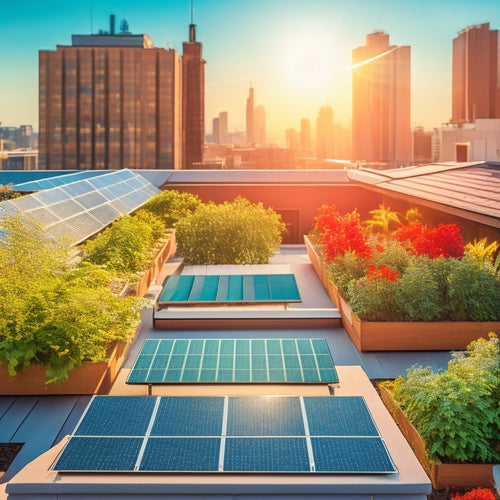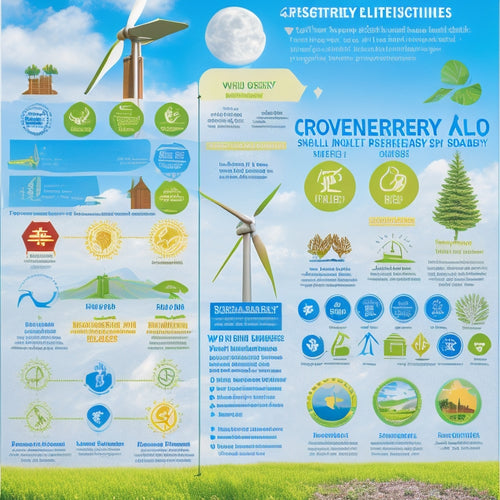What's the True Cost of Industrial Solar Maintenance?
Share
As you calculate the true cost of industrial solar maintenance, consider the annual expenses for regular upkeep, repairs, and replacement parts. The average cost of solar panel repair ranges from $1,000 to $5,000 per incident, while inverter replacement costs depend on type, quality, and labor. Cleaning and inspection fees add up, and neglecting maintenance can reduce energy output by up to 25%. To minimize downtime and lost production, prioritize preventative maintenance strategies, budget for unexpected repairs, and understand the cost of panel deterioration. By grasping these key factors, you'll uncover the full picture of industrial solar maintenance costs, and more.
Key Takeaways
• The true cost of industrial solar maintenance includes regular upkeep, repairs, and replacement parts, totaling $1,000 to $5,000 per incident.
• Inverter replacement costs depend on type, quality, and labor, with factors like warranty extensions and downtime affecting overall expenses.
• Cleaning and inspection fees range from $3,000 to $10,000 per megawatt, with regular cleaning preventing energy output reduction and increased maintenance costs.
• Budgeting for unexpected repairs is crucial, with a financial cushion set aside for unforeseen expenses, prioritized based on equipment age, condition, and risk assessment.
• Preventative maintenance strategies, including real-time monitoring and condition-based maintenance, can reduce downtime and extend equipment lifespan, ultimately minimizing the true cost of industrial solar maintenance.
Calculating Annual Maintenance Expenses
Calculating annual maintenance expenses for your industrial solar installation requires tallying up the costs of regular upkeep, repairs, and replacement parts. You'll need to take into account the frequency and cost of routine maintenance tasks, such as cleaning and inspecting the solar panels, as well as the cost of repairing or replacing components that fail or wear out.
A well-planned maintenance schedule can help you predict these expenses and avoid unexpected costs.
To accurately forecast maintenance expenses, you'll need to establish a maintenance schedule that outlines the timing and cost of each task. This schedule should consider the manufacturer's recommended maintenance intervals, as well as any additional maintenance tasks required by local regulations or industry standards.
Average Cost of Solar Panel Repair
When evaluating the average cost of solar panel repair, you'll need to take into account the frequency of repairs. This frequency depends on factors like environmental conditions, panel quality, and maintenance schedules.
On average, you can expect to pay between $1,000 and $5,000 per repair, depending on the type and severity of the issue.
Repair Frequency Factors
Understanding these factors is essential to accurately estimating the true cost of industrial solar maintenance.
System failures can be triggered by various weather patterns, such as:
-
Extreme temperatures: High temperatures can cause electrical components to malfunction, while low temperatures can lead to mechanical failures.
-
Humidity and precipitation: Moisture can seep into electrical connections, causing corrosion and short circuits.
-
Wind and debris: Strong winds can dislodge panels, while debris can scratch or break panels.
- UV radiation: Prolonged exposure to UV radiation can degrade panel materials, reducing their efficiency.
Average Repair Costs
On average, solar panel repairs can cost between $1,000 and $5,000 per incident, depending on the type and severity of the issue. As a solar plant owner, you'll want to factor these costs into your maintenance budget.
Labor costs are a significant contributor to the overall repair cost, ranging from $500 to $2,000 per day, depending on the location and type of repair. Additionally, the cost of replacement parts, such as inverters or panels, can add up quickly.
It's crucial to take into account warranty options when purchasing solar equipment. A thorough warranty can help mitigate repair costs by covering parts and labor for a specified period. However, be aware that warranties may come with maintenance requirements, such as regular inspections and cleaning, to remain valid.
When calculating the average cost of solar panel repair, you should also factor in the cost of downtime. Lost productivity due to equipment failure can result in significant revenue losses. By factoring in these costs, you can develop a more accurate understanding of the true cost of industrial solar maintenance.
Inverter Replacement Cost Factors
Your inverter replacement costs will depend on several key factors, including the type and quality of the replacement inverter, labor costs, and the complexity of the replacement process. The type of inverter you choose will have a notable impact on your overall cost. For instance, a high-efficiency inverter with advanced features like monitoring and tracking capabilities will be more expensive than a basic model.
Here are some key cost factors to take into account:
-
Inverter Upgrades: If you're replacing an old inverter with a newer, more efficient model, you may be eligible for incentives or rebates that can offset some of the costs.
-
Warranty Extensions: Check if the replacement inverter comes with a warranty extension, which can provide additional cost savings in the long run.
-
Labor Costs: The cost of hiring a professional to replace the inverter will vary depending on the complexity of the job and the location of your solar farm.
- Downtime and Lost Production: The longer the replacement process takes, the more you'll lose in terms of energy production and revenue.
Cleaning and Inspection Fees
As you consider the true cost of industrial solar maintenance, you'll need to factor in cleaning and inspection fees. These fees can add up quickly, especially if your system is located in an area prone to soil and debris accumulation.
Soil and Debris Removal
Regular soil and debris removal, a critical aspect of industrial solar maintenance, can add up to a significant portion of your annual operating expenses, with cleaning and inspection fees ranging from $3,000 to $10,000 per megawatt, depending on the site's location and size.
As you manage your industrial solar farm, you'll need to consider the impact of dust accumulation and vegetation management on your energy output. Failure to remove debris and dust can lead to:
-
Reduced energy output: Dust and debris can block sunlight, reducing energy production by up to 25%.
-
Increased maintenance costs: Neglecting regular cleaning can lead to more frequent and costly repairs.
-
Reduced panel lifespan: Failing to remove debris can cause premature wear and tear on your solar panels.
- Fire hazards: Dry vegetation and debris can create a fire risk, posing a significant threat to your solar farm.
Preventative Maintenance Costs
Cleaning and inspection fees, a significant component of preventative maintenance costs, can range from $3,000 to $10,000 per megawatt annually, depending on the site's location and size. As you manage your industrial solar plant, you'll need to factor in these costs to guarantee peak performance and extend the lifespan of your equipment.
Regular cleaning and inspections are vital to prevent soiling losses, which can reduce energy output by up to 25%. You may opt for automated cleaning systems or outsource to specialized service providers. Be sure to schedule maintenance during periods of low energy demand to minimize revenue losses.
Reviewing your solar insurance policy to understand what's covered under preventative maintenance is crucial. You may be able to claim reimbursement for some or all of these costs. By incorporating regular cleaning and inspections into your maintenance scheduling, you'll be able to identify potential issues before they become major problems, reducing downtime and lost revenue.
Electrical Testing and Troubleshooting
You'll need to conduct electrical testing and troubleshooting regularly to guarantee that your industrial solar panel system operates at peak levels and to identify potential electrical faults before they escalate into major issues. This process involves fault finding and circuit analysis to detect any anomalies in the system. Regular testing helps to prevent electrical shocks, fires, and equipment damage.
Here are some key aspects of electrical testing and troubleshooting:
-
Inspection of electrical connections: Verify that all connections are secure and not damaged.
-
Voltage and current measurements: Check for any deviations from the expected voltage and current readings.
-
Ground fault detection: Identify any ground faults that could lead to electrical shocks.
- Inverter performance analysis: Analyze the inverter's performance to make sure it's functioning within the specified parameters.
Panel Cleaning Methods and Prices
When it comes to maintaining your industrial solar panels running at peak efficiency, you'll need to contemplate the most effective and cost-efficient cleaning methods.
You're likely weighing the pros and cons of water-based cleaning methods versus investing in automated robotic cleaning systems.
In this section, you'll explore the benefits and drawbacks of each approach to determine the best fit for your operation.
Water-Based Cleaning Methods
Industrial solar panels require regular water-based cleaning to maintain peak energy output, with prices ranging from $0.01 to $0.05 per watt, depending on the frequency and method of cleaning. As you consider water-based cleaning methods, you'll want to weigh the importance of several key factors.
Here are 4 essential considerations for effective water-based cleaning:
-
Dry time: Guarantee the water is thoroughly evaporated to prevent water spots and mineral deposits.
-
Water quality: Use deionized or distilled water to minimize mineral buildup and reduce cleaning frequency.
-
Spray systems: Opt for low-pressure spray systems to prevent damage to the panels and reduce water consumption.
- Hose options: Choose hoses with UV-resistant materials and durable fittings to withstand harsh outdoor conditions.
Automated Robotic Cleaning Systems
Automated robotic cleaning systems, equipped with advanced guidance and precision cleaning capabilities, offer a highly efficient and cost-effective panel cleaning method, with prices ranging from $0.005 to $0.015 per watt, depending on the frequency and complexity of cleaning operations.
As you consider implementing this technology, you'll appreciate the benefits of reduced labor costs, increased efficiency, and minimized water usage.
Recent robotics advancements have enabled the development of more sophisticated and adaptable cleaning systems, capable of maneuvering through complex panel arrangements and optimizing cleaning routes. These systems can be integrated with existing monitoring and control systems, allowing for seamless data exchange and real-time monitoring.
When evaluating automated robotic cleaning systems, consider factors such as system integration, maintenance requirements, and scalability. By doing so, you'll be well-equipped to make an informed decision about the best solution for your solar maintenance needs.
With the right system in place, you can maximize energy production, reduce maintenance costs, and secure a higher return on investment for your industrial solar installation.
Preventative Maintenance Strategies
You can reduce downtime and extend equipment lifespan by implementing a proactive preventative maintenance strategy that targets high-failure components and identifies potential issues before they escalate into major problems. This approach enables you to prioritize maintenance resources effectively, reducing the risk of unexpected failures and minimizing revenue losses.
By identifying and addressing potential issues early, you can also reduce the likelihood of catastrophic failures, which can have significant financial and operational implications.
To develop an effective preventative maintenance strategy, consider the following key factors:
-
Risk Management: Identify high-risk components and prioritize maintenance accordingly.
-
Asset Prioritization: Focus on critical assets that have the greatest impact on overall system performance.
-
Failure Mode Analysis: Identify potential failure modes and develop targeted maintenance strategies to mitigate them.
- Condition-Based Maintenance: Use real-time monitoring data to trigger maintenance activities based on actual equipment condition.
Cost of Solar Panel Deterioration
To guarantee, it is crucial to
As solar panels deteriorate, their energy output diminishes, leading to significant revenue losses and increased operational expenses. You're likely aware that solar panels don't last forever, but did you know that panel degradation can result in energy losses of up to 1% per year? This may not seem like a lot, but it can add up quickly, especially in large-scale industrial solar farms.
| Year | Energy Loss | Revenue Loss |
|---|---|---|
| 1 | 0.5% | $1,000 |
| 5 | 2.5% | $5,000 |
| 10 | 5% | $10,000 |
| 15 | 7.5% | $15,000 |
As the table illustrates, the cumulative effect of panel degradation can result in substantial revenue losses over time. It's crucial to factor these losses into your maintenance strategy to ensure you're getting the most out of your solar investment. By understanding the true cost of panel degradation, you can make informed decisions about maintenance and replacement schedules, ultimately maximizing your return on investment.
Regular Inspection Checklists
To prevent minor issues from escalating into major problems, solar farm operators should establish a routine maintenance schedule that incorporates regular inspection checklists, ensuring that every component is thoroughly examined and potential faults are identified promptly. This proactive approach enables you to detect and address potential issues before they become major problems, reducing downtime and maximizing energy production.
When developing your inspection protocols, consider the following essential items to include in your checklist:
-
Electrical connections: Verify that all electrical connections are secure and show no signs of wear or corrosion.
-
Panel cleanliness: Inspect solar panels for dirt, debris, or other obstructions that may affect energy output.
-
Inverter functionality: Check inverters for proper operation, ensuring they're providing efficient power conversion.
- Structural integrity: Examine the solar farm's structural components, such as mounts and trackers, for signs of damage or wear.
Budgeting for Unexpected Repairs
Regular maintenance checks can help mitigate issues, but even with a proactive approach, unexpected repairs will still arise, and it's important to set aside a budget for these unforeseen expenses. As a solar plant operator, you understand the significance of risk assessment and having a financial cushion to absorb unexpected costs.
To budget for unexpected repairs, consider the following factors:
| Component | Average Repair Cost |
| Inverter | $5,000 - $10,000 |
| Tracker Motor | $2,000 - $5,000 |
| Panel Cleaning | $1,000 - $3,000 |
| Electrical Connection | $3,000 - $6,000 |
| Structural Repair | $10,000 - $20,000 |
When allocating your budget, consider the age and condition of your equipment, as well as the likelihood of failure. A thorough risk assessment can help you prioritize your budget and ensure you have a sufficient financial cushion to absorb unexpected expenses. By setting aside a dedicated fund for unexpected repairs, you can minimize downtime and guarantee continuous operation of your solar plant.
Frequently Asked Questions
Can I Perform Solar Panel Maintenance Tasks Myself to Save Money?
When considering DIY solar panel maintenance, remember the 2019 case study where a homeowner's attempt to clean panels without proper equipment resulted in damaged wiring. You risk DIY risks, compromising safety precautions, and potentially voiding warranties.
How Often Should I Inspect My Solar Panel System to Prevent Issues?
You should inspect your solar panel system regularly, performing routine checks every 3-6 months and seasonal assessments to detect potential issues before they become major problems, ensuring peak energy output and extending system lifespan.
Are There Any Tax Incentives for Solar Panel Maintenance and Repairs?
'Cut to the chase' - when it comes to solar panel maintenance and repairs, you're likely eligible for Federal Credits, State Rebates, and Local Exemptions, which can greatly offset costs, thanks to the current Energy Policy.
Can I Customize a Maintenance Plan to Fit My Specific Solar Panel System?
You can customize a maintenance plan tailored to your specific solar panel system, optimizing system integration and energy efficiency, ensuring maximum output and minimizing downtime, by identifying critical components and prioritizing tasks accordingly.
How Do I Determine if a Solar Panel Is Damaged Beyond Repair?
To determine if a solar panel is damaged beyond repair, you'll conduct a thorough panel examination, evaluating damage extent, type, and location, and then perform a damage assessment to calculate repair costs versus replacement value.
Related Posts
-

Solar System Installation Rebates and Tax Credits
Solar system installations offer beneficial rebates and tax credits that greatly cut your initial costs. You can bene...
-

Renewable Energy Certifications for Businesses
Renewable energy certifications are essential for your business, showcasing your commitment to sustainability and enh...
-

Energy-Efficient Heating and Cooling Appliances
Energy-efficient heating and cooling appliances can cut your energy bills markedly. By opting for models with high En...


